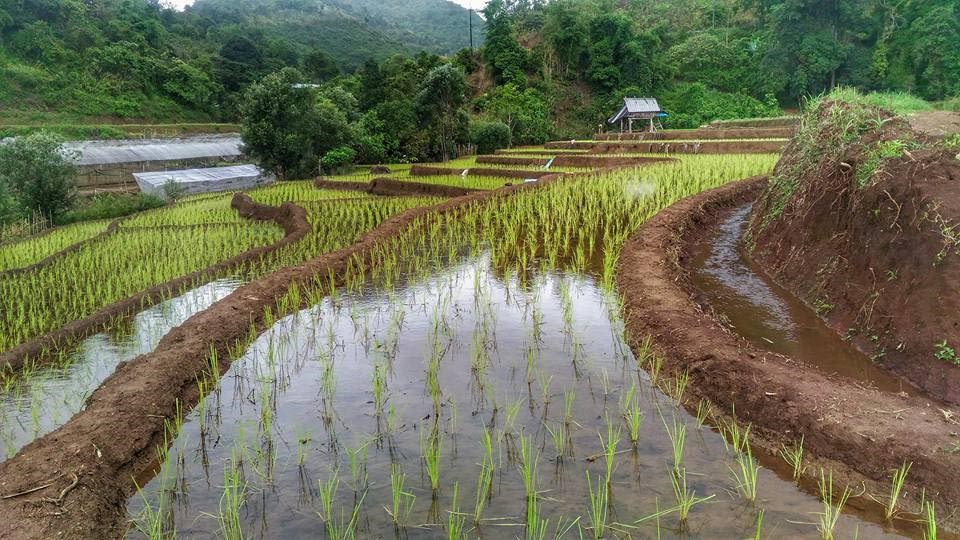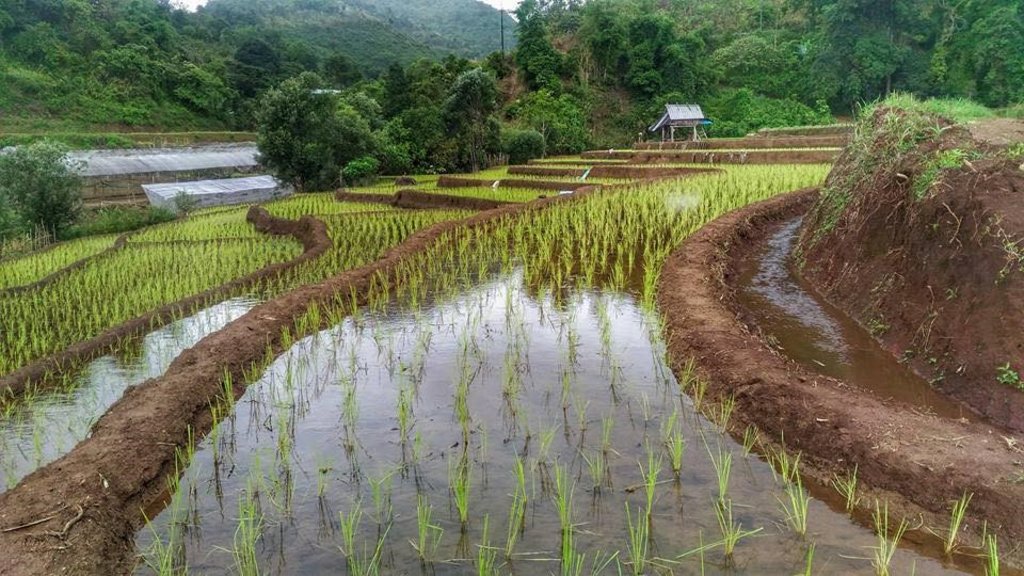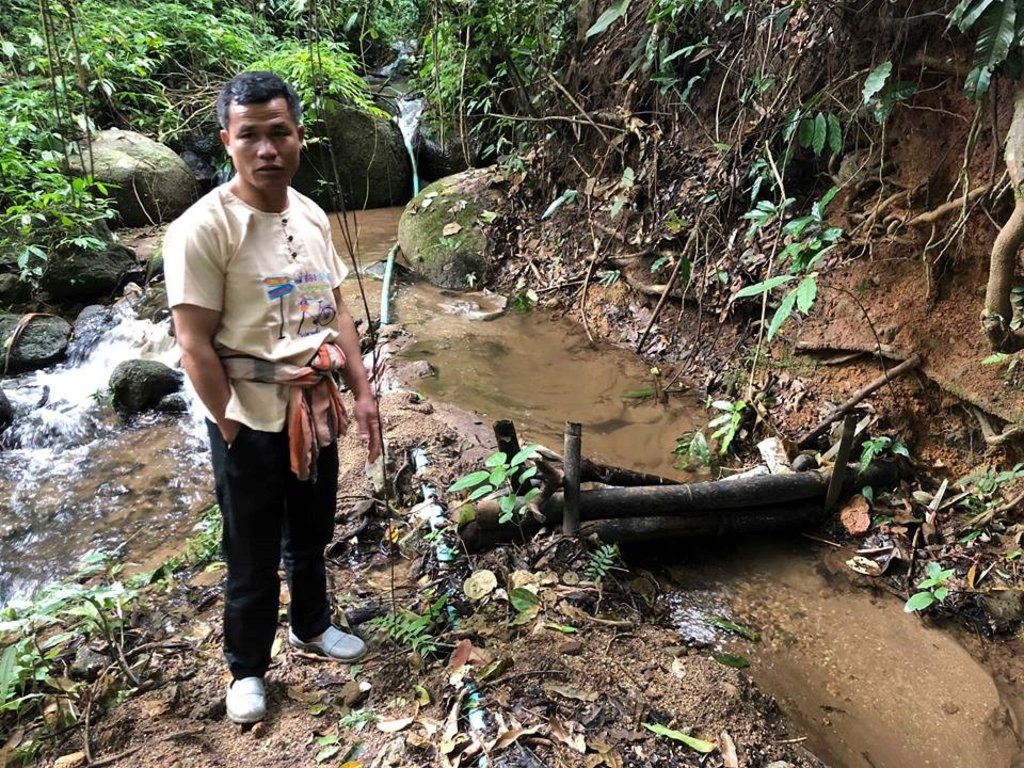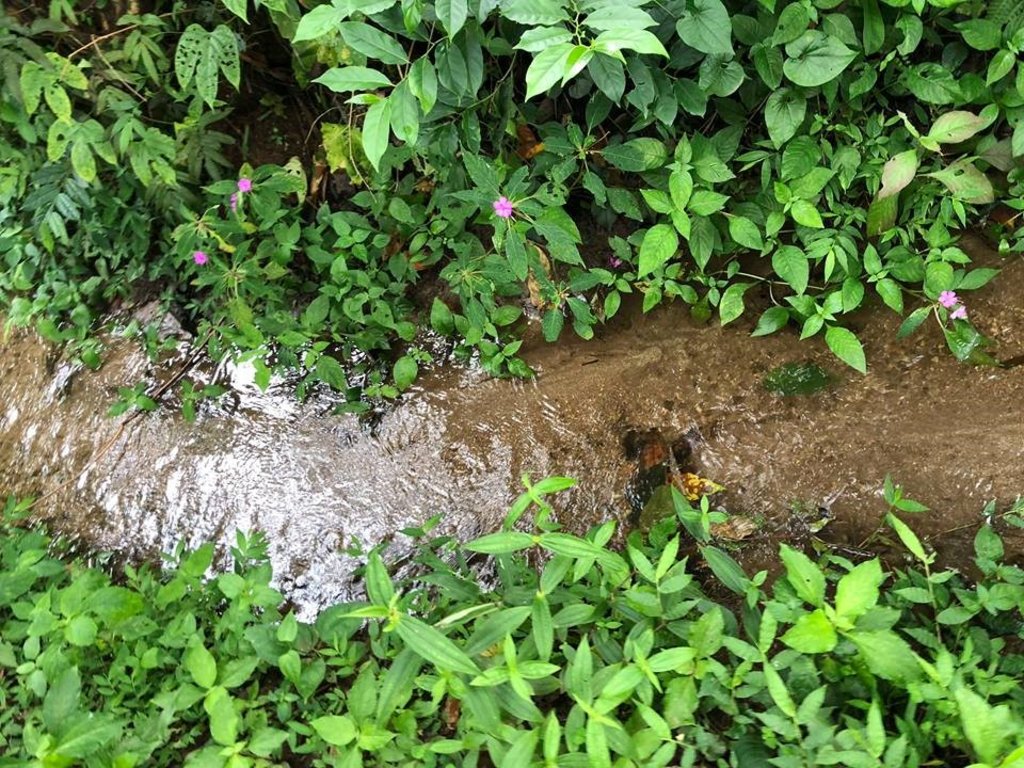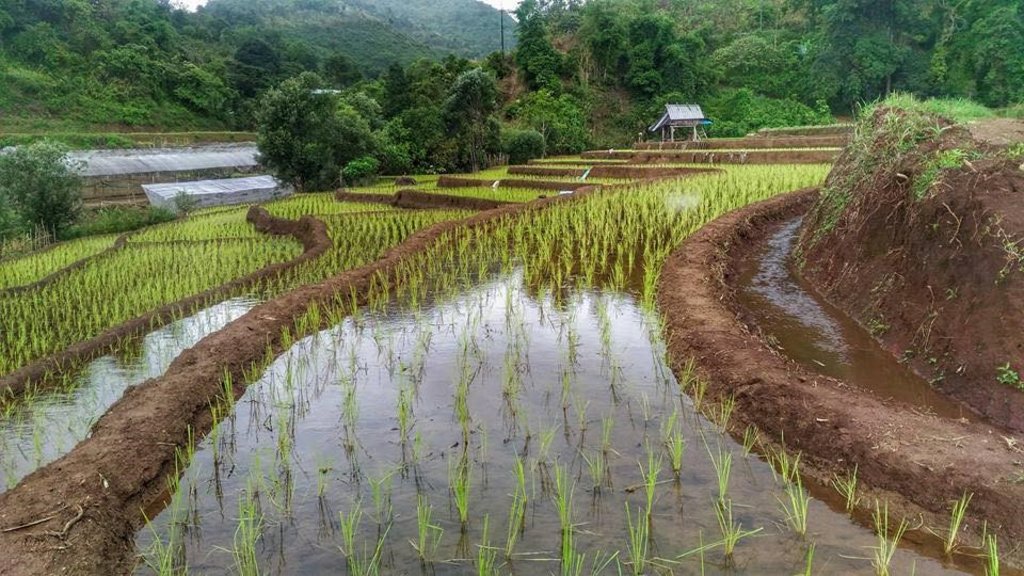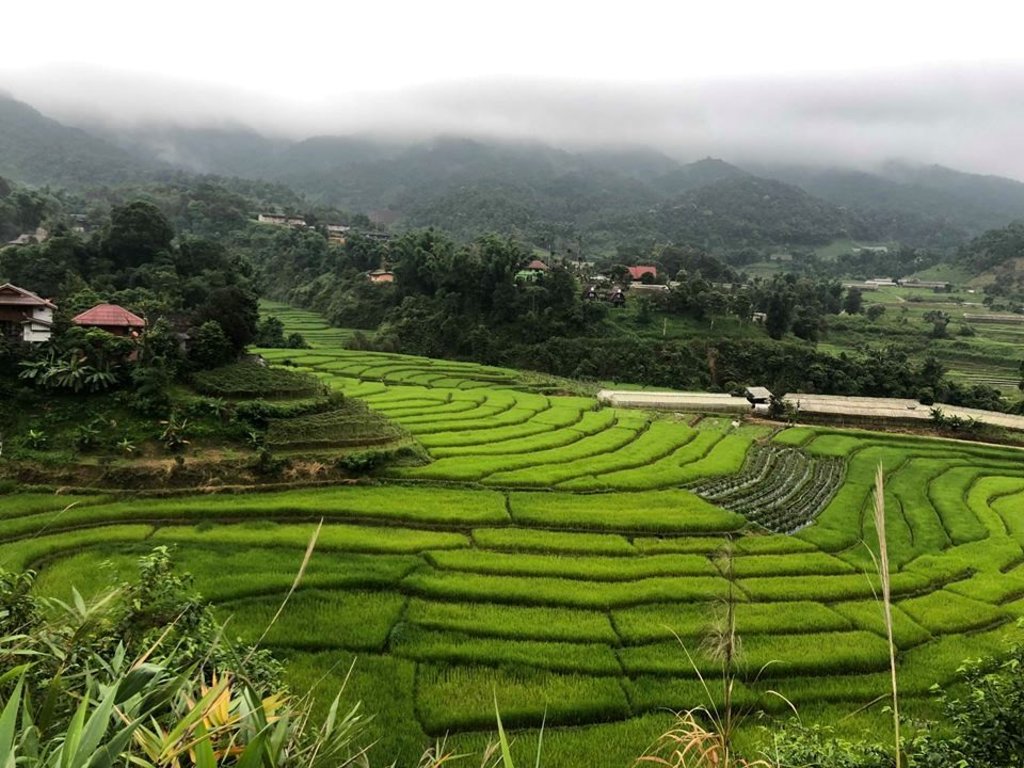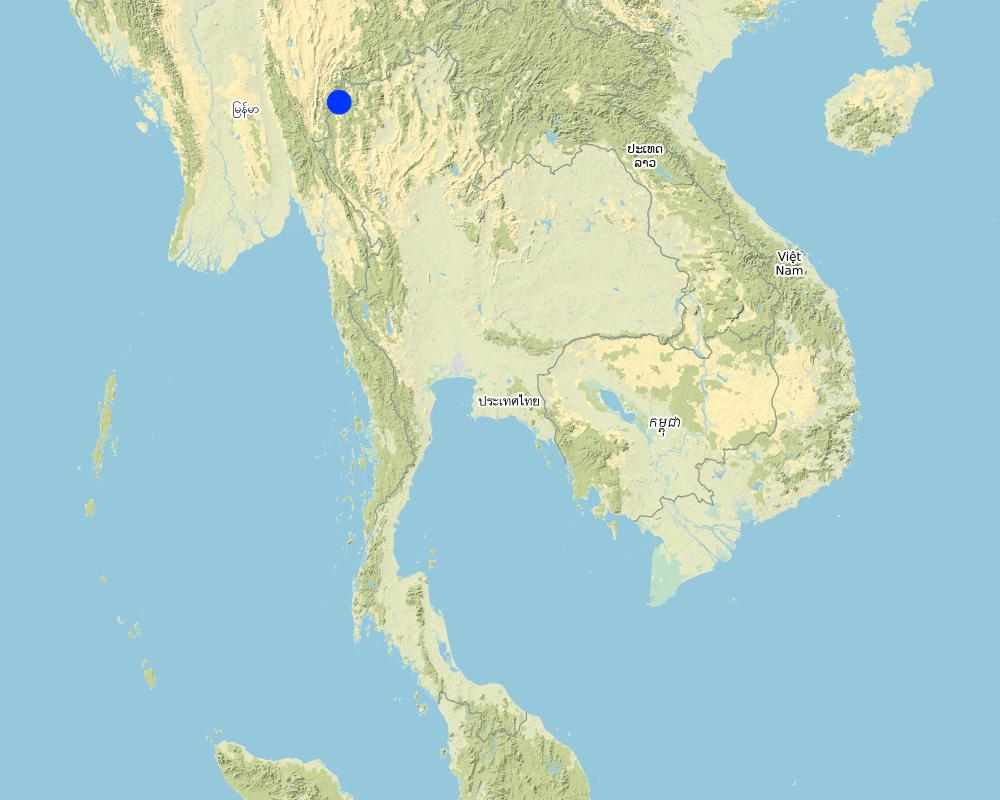Small Irrigation System for Highland Rice Terraces [Thaïlande]
- Création :
- Mise à jour :
- Compilateur : Pitayakon Limtong
- Rédacteur : –
- Examinateurs : Rima Mekdaschi Studer, William Critchley
Checkdam for highland rice terrace
technologies_4114 - Thaïlande
Voir les sections
Développer tout Réduire tout1. Informations générales
1.2 Coordonnées des personnes-ressources et des institutions impliquées dans l'évaluation et la documentation de la Technologie
Personne(s)-ressource(s) clé(s)
Spécialiste GDT:
Srisomkhew Sasirin
662 579 1409 / 669 8269 6410
sasirin0928@gmail.com / sasirin0928@gmail.com
Land Development Department
Paholyothin Road, Chatuchak, Bangkok 10999, Thailand
Thaïlande
SLM Consultant:
Limtong Pitayakon
66 89 444 6599
pitaya@ldd.go.th / pitaya49@msn.com
Land Development Department
Paholyothin Road, Chatuchak, Bangkok 10999, Thailand
Thaïlande
exploitant des terres:
Kayanyaiyie Mr.Vitoon
668 7188 0798
Soil Doctor Volunteer
Moo 5, Ban Don Village, Mae La Noi Sub-district, Huay Hom District, Mae Hong Son Province 58120
Thaïlande
exploitant des terres:
Kongvili Mr.Boonpan
668 4740 1550
47 Moo 5, Ban Don Village, Mae La Noi Sub-district, Huay Hom District, Mae Hong Son Province 58120
Thaïlande
exploitant des terres:
khangJing Mr.Suchat
668 3660 0272
1/2 Moo 5, Ban Don Village, Mae La Noi Sub-district, Huay Hom District, Mae Hong Son Province 58120
Thaïlande
exploitant des terres:
KangJing Mr.Somnuek
668 8764 1683
Village Headman
1 Moo 5, Ban Don Village, Mae La Noi Sub-district, Huay Hom District, Mae Hong Son Province 58120
Thaïlande
Nom du ou des institutions qui ont facilité la documentation/ l'évaluation de la Technologie (si pertinent)
Land Development Department LDD (Land Development Department LDD) - Thaïlande1.3 Conditions relatives à l'utilisation par WOCAT des données documentées
Quand les données ont-elles été compilées (sur le terrain)?
11/09/2018
Le compilateur et la(les) personne(s) ressource(s) acceptent les conditions relatives à l'utilisation par WOCAT des données documentées:
Oui
1.4 Déclaration sur la durabilité de la Technologie décrite
Est-ce que la Technologie décrite ici pose problème par rapport à la dégradation des terres, de telle sorte qu'elle ne peut pas être déclarée comme étant une technologie de gestion durable des terres?
Non
Commentaires:
Water supply systems in the high landscape rice terraces can prevent land degradation and also land users can utilize this area for producing rice in limited agricultural land. Because this system slows down the water flow, it reduces soil erosion into water courses and controls the amount of water that flows from the forest upstream to the rice terraces. This system increases water available to the rice terraces and improves the utilization of water, thus maximizing benefits for growth and yield of rice.
2. Description de la Technologie de GDT
2.1 Courte description de la Technologie
Définition de la Technologie:
An irrigation distribution system to highland rice terraces is required for agriculture on these highland slopes. It is based on the principles of water management in the area by diversion of water from natural watersheds upstream to the agricultural land - with regulation by village community consensus.
2.2 Description détaillée de la Technologie
Description:
The topography of this mountainous area, Mae La Noi District, Mae Hong Son Province, is complex. The height ranges from 994 -1,100 m above sea level (m asl). The main river is Mae La Noi. The climate is cool all year round. The annual average temperature is 25 degrees Celsius (⁰C), maximum temperature is 37⁰C in April, and minimum temperature is 8⁰C during December. The annual average rainfall is 1,500 mm and lasts from June to October. The number of households is 147, with total population of approx 763, 400 (Mae La Noi Royal Project Development Center, 2561). An irrigation distribution system to highland rice terraces is required for agriculture on these highland slopes. It is based on the principles of water management in the area by diversion of water from natural watersheds in the upstream areas to the agricultural land - with regulation by village community consensus. The steps of preparation are as follows. 1. Site selection: Rice terraces should be on suitable slopes, not more than 60 degrees, otherwise it will be difficult to excavate the slope and rice fields become very narrow. 2. Reshaping and leveling the slope: The sloping land for rice terrace should be reshaped and levelled by either manpower or mechanical means. The terraces can extend up to 50 m long, be as little as 1 m wide and 0.5 m deep, depending on the slope. The leveling of soil surface in the plot is done by releasing water into that plot and adjust the soil surface until a good level is attained. 3. Soil improvement: Generally, soil structure and fertility in the plots is very low because of reshaping and leveling. It is therefore necessary to restore and improve by application of organic matter, compost, animal manure, legumes, etc. Soil pH must be adjusted, and nutrients such as phosphorus and potassium should be added based on soil analytical results. 4. Rice cultivation: In the first years of cultivation, the terraces may not store water at the desired level, so rice is planted in small holes. Normally, farmers plant rice seedlings (3-5 seedlings per hole) at a spacing of 20 x 20 cm. 5. Fertilizer application: In this highland area focus should be on organic fertilizers to reduce costs, because people can find materials locally such as animal manure and plant residues. 6. Water supply system: Distribution of water to the rice terraces is managed by small dams or weirs to release suitable amount of water through a small water channel to rice terraces. This water distribution system will spread water to all land users in this area, and there is sufficient water for farming throughout the year. 7. Disease and insect control: Most rice varieties are native, so they have high resistance. But there could be some disease/insect outbreaks; they have to be protected according to instructions. The submerged condition in the paddy field can help control weeds, but some labour is still needed. 8. Maintenance: For small dams or weirs, small water channels and terraces, it is necessary to restore and maintain twice a year, i.e. before and after harvest.
2.3 Photos de la Technologie
2.4 Vidéos de la Technologie
Date:
11/09/2018
Lieu:
Mae La Noi District, Mae Hong Son Province, Thailand
Nom du vidéaste:
Ms.Sasirin Srisomkhew
Date:
21/03/2018
Lieu:
Mae La Noi District, Mae Hong Son Province, Thailand
Date:
11/09/2018
Lieu:
Mae La Noi District, Mae Hong Son Province, Thailand
Nom du vidéaste:
Ms.Sasirin Srisomkhew
2.5 Pays/ région/ lieux où la Technologie a été appliquée et qui sont couverts par cette évaluation
Pays:
Thaïlande
Région/ Etat/ Province:
Mae La Noi District, Mae Hong Son Province, Thailand
Map
×2.6 Date de mise en œuvre de la Technologie
Si l'année précise est inconnue, indiquez la date approximative: :
- il y a plus de 50 ans (technologie traditionnelle)
2.7 Introduction de la Technologie
Spécifiez comment la Technologie a été introduite: :
- dans le cadre d'un système traditionnel (> 50 ans)
3. Classification de la Technologie de GDT
3.1 Principal(aux) objectif(s) de la Technologie
- réduire, prévenir, restaurer les terres dégradées
- protéger un bassin versant/ des zones situées en aval - en combinaison avec d'autres technologies
- réduire les risques de catastrophes
- s'adapter au changement et aux extrêmes climatiques et à leurs impacts
- atténuer le changement climatique et ses impacts
3.2 Type(s) actuel(s) d'utilisation des terres, là où la Technologie est appliquée

Terres cultivées
- Cultures annuelles
Principales cultures (vivrières et commerciales):
Paddy rice and vegetables such as chili, cabbage

Voies d'eau, plans d'eau, zones humides
- Voies de drainage, voies d'eau
Principaux produits/ services:
Small dams or weirs with small water channels to supply/distribute water to rice terraces.
Commentaires:
Farmers in the area will grow rice in the rainy season for household consumption. The duration of cultivation until harvesting is about 6 months. In the dry season, the farms are converted to several kind of vegetables under support by the Royal Project Foundation.
3.3 Informations complémentaires sur l'utilisation des terres
Approvisionnement en eau des terres sur lesquelles est appliquée la Technologie:
- pluvial
Commentaires:
The system of water supply of this technology distributes water resources from forest upstream to the rice terrace.
Nombre de période de croissance par an: :
- 3
Précisez:
Paddy rice once a year and vegetables 1-2 crops a year
3.4 Groupe de GDT auquel appartient la Technologie
- mesures en travers de la pente
- dérivation et drainage de l'eau
3.5 Diffusion de la Technologie
Spécifiez la diffusion de la Technologie:
- appliquée en des points spécifiques ou concentrée sur une petite surface
Commentaires:
This water system covered around 200 households, each household covers an area of 0.5 hectare.
3.6 Mesures de GDT constituant la Technologie

structures physiques
- S1: Terrasses

modes de gestion
- M7: Autres
3.7 Principaux types de dégradation des terres traités par la Technologie

érosion hydrique des sols
3.8 Prévention, réduction de la dégradation ou réhabilitation des terres dégradées
Spécifiez l'objectif de la Technologie au regard de la dégradation des terres:
- prévenir la dégradation des terres
4. Spécifications techniques, activités, intrants et coûts de mise en œuvre
4.1 Dessin technique de la Technologie
Auteur:
Ms.Sasirin Srisomkhew
Date:
25/09/2018
4.2 Spécification/ explications techniques du dessin technique
The irrigation water distribution system for highland rice terraces by farmers in the village is suitable for highland, sloping agriculture, with slopes ranging from 5-60 degrees. It is based on the principles of water management in the area by diversion of water from natural watersheds in the upstream zone to the agricultural land through the consensus of community members. Distribution of water to the rice terraces is managed by small dams or weir which are used to divert and release suitable amount of water through small water channels to rice terraces. The terraces can extend up to 50m long, 1m (or more) wide and 0.5m deep, depending on the degree of the slope. This water distribution system will spread water to all land users in this area, and there is sufficient water for farming throughout the year.
4.3 Informations générales sur le calcul des intrants et des coûts
Spécifiez la manière dont les coûts et les intrants ont été calculés:
- par superficie de la Technologie
Indiquez la taille et l'unité de surface:
0.48 hectare for each farmer
autre/ monnaie nationale (précisez):
Baht (THB)
Indiquer le taux de change du dollars en monnaie locale (si pertinent): 1 USD= :
32,0
Indiquez le coût salarial moyen de la main d'œuvre par jour:
300
4.4 Activités de mise en place/ d'établissement
| Activité | Type de mesures | Calendrier | |
|---|---|---|---|
| 1. | prepare small dam and water canal | Structurel | in the first year |
| 2. | prepare terraces and land leveling | Structurel | in the first year |
| 3. | cultivation | Structurel | before rainny season |
| 4. | soil improvement | Modes de gestion | after preparing and cultivating the soil |
| 5. | rice planting | Végétale | rainy season |
| 6. | fertilizer application | Modes de gestion | after planting |
| 7. | irrigation | Modes de gestion | after planting |
| 8. | disease, pest and weed control | Modes de gestion | after planting |
| 9. | havesting | Agronomique | when rice grains are mature |
| 10. | None | None |
4.5 Coûts et intrants nécessaires à la mise en place
Si possible, ventilez le coût de la mise en place selon le tableau suivant: spécifiez les intrants et le coût par intrant. Si vous n'êtes pas en mesure de ventiler le coût, donnez une estimation du coût total de la mise en place de la Technologie:
98100,0
| Spécifiez les intrants | Unité | Quantité | Coûts par unité | Coût total par intrant | % des coût supporté par les exploitants des terres | |
|---|---|---|---|---|---|---|
| Main d'œuvre | prepare dam and canal | 7x10 | 70,0 | 300,0 | 21000,0 | 100,0 |
| Main d'œuvre | planting | 7x1 | 7,0 | 300,0 | 2100,0 | 100,0 |
| Main d'œuvre | maintainance | 20x2 | 40,0 | 300,0 | 12000,0 | 100,0 |
| Main d'œuvre | harvesting | 20x7 | 140,0 | 300,0 | 42000,0 | 100,0 |
| Equipements | tractor | set | 1,0 | 3000,0 | 3000,0 | 100,0 |
| Equipements | fuel | liter | 20,0 | 30,0 | 600,0 | 100,0 |
| Matériel végétal | rice seed | bag | 3,0 | 100,0 | 300,0 | 100,0 |
| Matériel végétal | chili seed | plant | 5000,0 | 2,0 | 10000,0 | 100,0 |
| Engrais et biocides | fertilizer 21-0-0 | bag | 3,0 | 400,0 | 1200,0 | 100,0 |
| Engrais et biocides | fertilizer 15-15-15 | bag | 3,0 | 700,0 | 2100,0 | 100,0 |
| Engrais et biocides | fertilizer 16-20-0 | bag | 3,0 | 600,0 | 1800,0 | 100,0 |
| Engrais et biocides | animal manure | bag | 10,0 | 200,0 | 2000,0 | 100,0 |
| Coût total de mise en place de la Technologie | 98100,0 | |||||
Commentaires:
Labour of small and canal preparation was paid in the first year, after that paid for maintain all of these structuer.
4.6 Activités d'entretien/ récurrentes
| Activité | Type de mesures | Calendrier/ fréquence | |
|---|---|---|---|
| 1. | restoration and maintain dam, canal and terrace | Structurel | 2 times a year |
4.7 Coûts et intrants nécessaires aux activités d'entretien/ récurrentes (par an)
Si possible, ventilez le coût de l'entretien selon le tableau suivant: spécifiez les intrants et le coût par intrant. Si vous n'êtes pas en mesure de ventiler le coût, donnez une estimation du coût total de l'entretien de la Technologie:
1800,0
| Spécifiez les intrants | Unité | Quantité | Coûts par unité | Coût total par intrant | % des coût supporté par les exploitants des terres | |
|---|---|---|---|---|---|---|
| Main d'œuvre | restoring and maintaining the dam, water canal and terraces | 2dx3m | 6,0 | 300,0 | 1800,0 | 100,0 |
| Coût total d'entretien de la Technologie | 1800,0 | |||||
Si le coût n'est pas pris en charge à 100% par l'exploitant des terres, indiquez qui a financé le coût restant:
Land user spend their money for 100% of costs
4.8 Facteurs les plus importants affectant les coûts
Décrivez les facteurs les plus importants affectant les coûts :
The most important factors that affect the costs is the labour factor, where farmers need to hire labourers for rice cultivation such as planting, fertilizer application, maintaining the system and harvesting, including, the excavation and restoration of the small dam, water channels and terraces.
5. Environnement naturel et humain
5.1 Climat
Précipitations annuelles
- < 250 mm
- 251-500 mm
- 501-750 mm
- 751-1000 mm
- 1001-1500 mm
- 1501-2000 mm
- 2001-3000 mm
- 3001-4000 mm
- > 4000 mm
Spécifiez la pluviométrie moyenne annuelle (si connue), en mm:
1500,00
Zone agro-climatique
- subhumide
5.2 Topographie
Pentes moyennes:
- plat (0-2 %)
- faible (3-5%)
- modéré (6-10%)
- onduleux (11-15%)
- vallonné (16-30%)
- raide (31-60%)
- très raide (>60%)
Reliefs:
- plateaux/ plaines
- crêtes
- flancs/ pentes de montagne
- flancs/ pentes de colline
- piémonts/ glacis (bas de pente)
- fonds de vallée/bas-fonds
Zones altitudinales:
- 0-100 m
- 101-500 m
- 501-1000 m
- 1001-1500 m
- 1501-2000 m
- 2001-2500 m
- 2501-3000 m
- 3001-4000 m
- > 4000 m
Indiquez si la Technologie est spécifiquement appliquée dans des:
- situations convexes
5.3 Sols
Profondeur moyenne du sol:
- très superficiel (0-20 cm)
- superficiel (21-50 cm)
- modérément profond (51-80 cm)
- profond (81-120 cm)
- très profond (>120 cm)
Texture du sol (de la couche arable):
- moyen (limoneux)
Texture du sol (> 20 cm sous la surface):
- moyen (limoneux)
Matière organique de la couche arable:
- abondant (>3%)
5.4 Disponibilité et qualité de l'eau
Profondeur estimée de l’eau dans le sol:
en surface
Disponibilité de l’eau de surface:
bonne
Qualité de l’eau (non traitée):
eau potable
La salinité de l'eau est-elle un problème? :
Non
La zone est-elle inondée?
Non
5.5 Biodiversité
Diversité des espèces:
- moyenne
Diversité des habitats:
- moyenne
5.6 Caractéristiques des exploitants des terres appliquant la Technologie
Sédentaire ou nomade:
- Sédentaire
Orientation du système de production:
- subsistance (auto-approvisionnement)
- commercial/ de marché
Revenus hors exploitation:
- 10-50% de tous les revenus
Niveau relatif de richesse:
- moyen
Individus ou groupes:
- individu/ ménage
Niveau de mécanisation:
- travail manuel
- mécanisé/ motorisé
Genre:
- femmes
- hommes
Age des exploitants des terres:
- personnes d'âge moyen
- personnes âgées
5.7 Superficie moyenne des terres détenues ou louées par les exploitants appliquant la Technologie
- < 0,5 ha
- 0,5-1 ha
- 1-2 ha
- 2-5 ha
- 5-15 ha
- 15-50 ha
- 50-100 ha
- 100-500 ha
- 500-1 000 ha
- 1 000-10 000 ha
- > 10 000 ha
Cette superficie est-elle considérée comme de petite, moyenne ou grande dimension (en se référant au contexte local)?
- moyenne dimension
5.8 Propriété foncière, droits d’utilisation des terres et de l'eau
Propriété foncière:
- individu, sans titre de propriété
Droits d’utilisation des terres:
- communautaire (organisé)
Droits d’utilisation de l’eau:
- communautaire (organisé)
5.9 Accès aux services et aux infrastructures
emploi (par ex. hors exploitation):
- pauvre
- modéré
- bonne
énergie:
- pauvre
- modéré
- bonne
- pauvre
- modéré
- bonne
6. Impacts et conclusions
6.1 Impacts sur site que la Technologie a montrés
Impacts socio-économiques
Production
production agricole
qualité des cultures
Disponibilité et qualité de l'eau
disponibilité de l'eau potable
qualité de l'eau potable
disponibilité de l'eau d'irrigation
qualité de l'eau d'irrigation
Revenus et coûts
dépenses pour les intrants agricoles
charge de travail
Impacts socioculturels
sécurité alimentaire/ autosuffisance
situation sanitaire
droits d'utilisation des terres/ de l'eau
opportunités culturelles
possibilités de loisirs
institutions communautaires
connaissances sur la GDT/ dégradation des terres
Impacts écologiques
Cycle de l'eau/ ruissellement
quantité d'eau
qualité de l'eau
récolte/ collecte de l'eau
ruissellement de surface
drainage de l'excès d'eau
nappes phréatiques/ aquifères
Sols
perte en sol
accumulation de sol
matière organique du sol/ au dessous du sol C
acidité
Biodiversité: végétale, animale
biomasse/ au dessus du sol C
diversité végétale
diversité animale
espèces bénéfiques
Réduction des risques de catastrophe et des risques climatiques
impacts des inondations
impacts de la sécheresse
émissions de carbone et de gaz à effet de serre
6.2 Impacts hors site que la Technologie a montrés
disponibilité de l'eau
flux des cours d'eau fiables et stables en saison sèche
inondations en aval
envasement en aval
pollution des rivières/ nappes phréatiques
impact des gaz à effet de serre
6.3 Exposition et sensibilité de la Technologie aux changements progressifs et aux évènements extrêmes/catastrophes liés au climat (telles que perçues par les exploitants des terres)
Changements climatiques progressifs
Changements climatiques progressifs
| Saison | Type de changements/ extrêmes climatiques | Comment la Technologie fait-elle face à cela? | |
|---|---|---|---|
| températures annuelles | modérément | ||
| températures saisonnières | été | pas bien | |
| précipitations annuelles | bien |
Extrêmes climatiques (catastrophes)
Catastrophes météorologiques
| Comment la Technologie fait-elle face à cela? | |
|---|---|
| pluie torrentielle locale | modérément |
| orage local | modérément |
| averse de grêle locale | modérément |
Catastrophes climatiques
| Comment la Technologie fait-elle face à cela? | |
|---|---|
| feu de forêt | modérément |
Catastrophes biologiques
| Comment la Technologie fait-elle face à cela? | |
|---|---|
| maladies épidémiques | pas bien du tout |
| infestation par des insectes/ vers | pas bien du tout |
6.4 Analyse coûts-bénéfices
Quels sont les bénéfices comparativement aux coûts de mise en place (du point de vue des exploitants des terres)?
Rentabilité à long terme:
très positive
Quels sont les bénéfices comparativement aux coûts d'entretien récurrents (du point de vue des exploitants des terres)?
Rentabilité à long terme:
très positive
6.5 Adoption de la Technologie
- plus de 50%
Parmi tous ceux qui ont adopté la Technologie, combien d'entre eux l'ont fait spontanément, à savoir sans recevoir aucune incitation matérielle ou aucun paiement?
- 90-100%
6.6 Adaptation
La Technologie a-t-elle été récemment modifiée pour s'adapter à l'évolution des conditions?
Non
6.7 Points forts/ avantages/ possibilités de la Technologie
| Points forts/ avantages/ possibilités du point de vue de l'exploitant des terres |
|---|
| The villagers are self-reliant by living in balance between demand and supply to meet their own needs. So every household will grow rice for their consumption and solve some problems in water management of these rice terraces by their community. |
| Villagers have knowledge and technology of water management and systematically and continuously transfer to other land users from generation to generation, causing a connection between kinship and community. There are groups to solve the main problems of the community. |
| Villagers have a stable and strong mental state with the hard thinking to fight the obstacle in the way of living, to achieve a more prosperous life. Individual communities have strength in self-reliance, and also have strong mind in learning, having virtue and rationality in thinking and decision-making. |
| They have the ability to promote agriculture with natural resources and ecological tourism and develop the communication system for visitors to access the local information and facilities. |
| Points forts/ avantages/ possibilités du point de vue du compilateur ou d'une autre personne ressource clé |
|---|
| The selection of appropriate technology can solve the problem of soil degradation, reduce soil erosion and manage adequate water supply to agricultural area for the whole year. |
| The villagers have to rely and trust on each other with high willingness to share their knowledge and experience. |
| Communities have the ability to use existing natural resources in maximizing benefits, and at the same time they try to conserve and prevent soil degradation in this area. |
| Community networking allows them to conduct activities to achieve self-reliance. |
6.8 Faiblesses/ inconvénients/ risques de la Technologie et moyens de les surmonter
| Faiblesses/ inconvénients/ risques du point de vue de l’exploitant des terres | Comment peuvent-ils être surmontés? |
|---|---|
| Land users’ lack of ownership of the land that cannot be legally owned by individuals, as the area is located in a preserved forest. The villagers therefore might be afraid to move out of the area in the future. | The community leaders and villagers need to solve this problem, one thing being that they should ask the government to help. |
| Lack of opportunities for children to have education caused by the poverty of their parents. | Schools in the area have increased educational opportunities for poor children by sponsoring underprivileged children. |
| Lack of social and health welfare because this area is far from the city. Villagers will not be able to reach the hospital in time in the case of emergency. | Villagers take the right treatment from the gold card or project 30 baht free treatment of all diseases for emergency situations. |
| Lack the coverage of energy and communication system in this area. Some areas still lack electricity, telephone and internet facilities. | Some villagers purchased and installed solar panels for their own use. |
| Faiblesses/ inconvénients/ risques du point de vue du compilateur ou d'une autre personne ressource clé | Comment peuvent-ils être surmontés? |
|---|---|
| The villagers lack the ownership of the land, which located in the conserved forest. That means they do not have right to hold the land. | The government has a policy to solve these problems, and at the same time serve and arrange this preserved forest as natural resource. |
| Lack of educational opportunities, The study site is located in a remote area. Children living there lack opportunities in education. | The government has a policy to give underprivileged children equal education to children. |
| Villagers lack social and health welfare because of the remoteness of the place that they live. It is difficult to access medical treatment and hospital. | The government has set up and supported the budget to develop district health promotion hospitals in the sub-district level. |
7. Références et liens
7.1 Méthodes/ sources d'information
- visites de terrain, enquêtes sur le terrain
- interviews/entretiens avec les exploitants des terres
- interviews/ entretiens avec les spécialistes/ experts de GDT
- compilation à partir de rapports et d'autres documents existants
7.3 Liens vers les informations pertinentes disponibles en ligne
Titre/ description:
Ecological tourism of Mae La Noi Development Center, Royal Project
URL:
https://www.youtube.com/watch?v=818zn7JMKsU
Titre/ description:
Mae La Noi Royal Project Foundation
URL:
https://www.youtube.com/watch?v=M8pFfl18fC8
Titre/ description:
Mae La Noi Development Center of Royal Project Foundation
URL:
http://www.mhsdc.org/interest510.htm
Titre/ description:
History of Mae La Noi Development Center
URL:
http://www.mhsdc.org/rypmaenoi.htm
Titre/ description:
Mae La Noi Project for tourism of beautiful paddy rice terrace
URL:
https://mgronline.com/travel/detail/9590000106920
Titre/ description:
Mae La Noi Development Center of Royal Project Foundation
URL:
http://royalprojectthailand.com/maelanoi
Titre/ description:
Rice terrace in highland
URL:
http://www.ricethailand.go.th/rkb/management/index.php
Liens et modules
Développer tout Réduire toutLiens
Aucun lien
Modules
Aucun module trouvé


